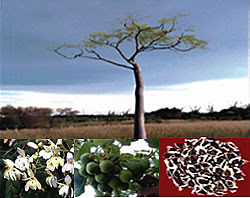Himalayan plants have anti-diabtic agents
21 plant species found here can help check diabetes
Merina Sharma
Kathmandu, May 24:
A recent research on Nepali plants and herbs used traditionally revealed that 21 plant species have anti-diabetic properties.
The 21 species including, acacia catechu (Khayar), allium hypsistum (Jimmu), berginia ciliate (Paashanbed), cedrus deodara (Debdar), sapindus mukorossi (Rittha), rubia manjith (Majitho) and woodfordia fruticosa (amar phool) contain anti-diabetic agents. Stems, leaves, roots, barks, fruits and flowers of these plants were extracted as samples for the study.
While examining the active compounds of Paashanbed, two active compounds —
galloylepicatechin and galloylcatechin — were found for the first time in a plant other than green tea. They are considered to be the most potent components with anti-diabetic potential, believed to be in the green tea alone.
The revelation was made after a two-year research conducted by Dr Megh Raj Bhandari, food researcher of Department of Food Technology and Quality Control (DFTQC) in the Hokkaido University, Japan, with the financial support of the government of Japan. Eighty-three plant species used in the Nepali traditional medicinal system were collected from different parts of the country for the study.
Dr Bhandari said the discovery would help develop new and efficient drugs and functional food for diabetes. “Though some of these herbs were used for the treatment of diabetes and traditionally produced some herbal medicines but there was no scientific ground to prove it,” he said.
Dr Bhandari added that the people could consume anti-diabetic components in their daily meal and reduce the risk of the disease. “The anti-diabetic components could be utilised by the local food companies to prepare functional food,” he added.
According to a data of the World Health Organisation (WHO), more than 171 million people are suffering from diabetes worldwide and the number is expected to double by 2030. It has also stated that 80 per cent of these people belong to the developing nations. More than four lakh Nepalis are believed to be suffering from the disease and the number is expected to increase by three folds in 2030.
The findings of the research were recently published in a book titled ‘Functional Food for the Prevention of Chronic Diseases,’ published by the Functional Food Centre, USA.
Source: click here
Merina Sharma
Kathmandu, May 24:
A recent research on Nepali plants and herbs used traditionally revealed that 21 plant species have anti-diabetic properties.
The 21 species including, acacia catechu (Khayar), allium hypsistum (Jimmu), berginia ciliate (Paashanbed), cedrus deodara (Debdar), sapindus mukorossi (Rittha), rubia manjith (Majitho) and woodfordia fruticosa (amar phool) contain anti-diabetic agents. Stems, leaves, roots, barks, fruits and flowers of these plants were extracted as samples for the study.
While examining the active compounds of Paashanbed, two active compounds —
galloylepicatechin and galloylcatechin — were found for the first time in a plant other than green tea. They are considered to be the most potent components with anti-diabetic potential, believed to be in the green tea alone.
The revelation was made after a two-year research conducted by Dr Megh Raj Bhandari, food researcher of Department of Food Technology and Quality Control (DFTQC) in the Hokkaido University, Japan, with the financial support of the government of Japan. Eighty-three plant species used in the Nepali traditional medicinal system were collected from different parts of the country for the study.
Dr Bhandari said the discovery would help develop new and efficient drugs and functional food for diabetes. “Though some of these herbs were used for the treatment of diabetes and traditionally produced some herbal medicines but there was no scientific ground to prove it,” he said.
Dr Bhandari added that the people could consume anti-diabetic components in their daily meal and reduce the risk of the disease. “The anti-diabetic components could be utilised by the local food companies to prepare functional food,” he added.
According to a data of the World Health Organisation (WHO), more than 171 million people are suffering from diabetes worldwide and the number is expected to double by 2030. It has also stated that 80 per cent of these people belong to the developing nations. More than four lakh Nepalis are believed to be suffering from the disease and the number is expected to increase by three folds in 2030.
The findings of the research were recently published in a book titled ‘Functional Food for the Prevention of Chronic Diseases,’ published by the Functional Food Centre, USA.
Source: click here


Comments